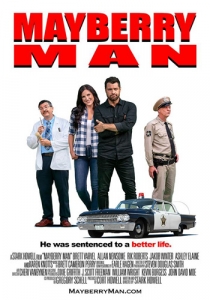Curating Without Copying – the Mayberry Man
“An arrogant movie star is trapped in a modern day Mayberry where he’s given a chance to discover the true meaning of friendship and family,” reads the review of the new movie Mayberry Man.
“The Mayberry Man movie nods to ‘Andy Griffith Show’ without copying,” writes Domenica Bongiovanni in the Indianapolis Star. The movie’s creator, Stark Howell, had assigned himself a tall order, the reporter points out – capturing the spirit of the original show without mirroring The movie was meant to appeal to a very targeted audience (fans of the former show and of the Mayberry festivals), and finding ways to be original was going to be the challenge.
Howell himself refers to the film as “almost a period piece without being a period piece,” noting that the message is one for post-COVID, 21st century viewers re-examining their priorities in light of the world of yesterday, where there seemed to have been more generosity along with more pie-eating contests.
From my blog content writer’s point of view, what this film’s creator has achieved is curating without copying, serving up existing material and then offering his own unique insights relative to that material.
“Curated content and duplicate content are NOT the same thing,” explains Kudani.com. “Duplicate content is frowned upon, while curated content is encouraged.” Content curation is going out on to the web, and finding high quality content, and then organizing and streamlining that content in a way that provides an additional level of value to your readers and followers.”
Needless to say, as we teach content writers a at Say It For You, the content being curated must be properly attributed to its original author. Howell hardly pretends to have created the persona of Andy Griffith; he is demonstrating to modern day viewers a way to glean wisdom from that earlier and more innocent environment.
“Remember, the internet is all about sharing,” Kudani reminds readers. I agree, I think of curation as sharing+. As a freelance blog writer, I’ve always known that linking to outside sources is a good tactic for adding breadth and depth to my blog content. Linking to a news source or magazine article, for instance, adds credibility to the ideas I’m expressing on behalf of Say It For You client companies. What’s more, I tell owners and content writers, when you link to another blog content writer’s comments about the subject you’re covering, that’s a way to reinforce your point, at the same time showing you’re staying in touch with others in your industry.
As the Mayberry Man clearly demonstrates, curation is capturing the spirit of original content without mirroring!’’




Follow us online!